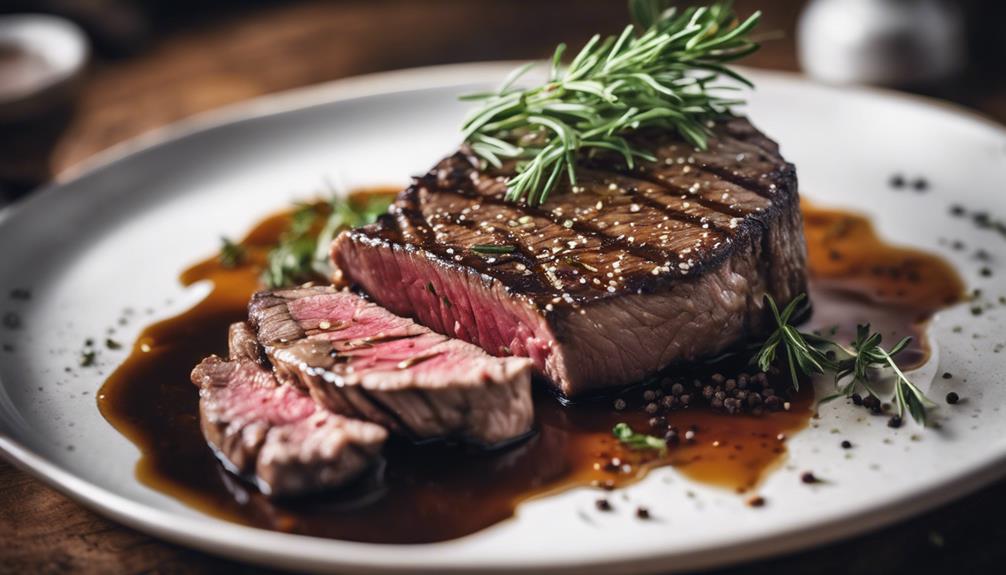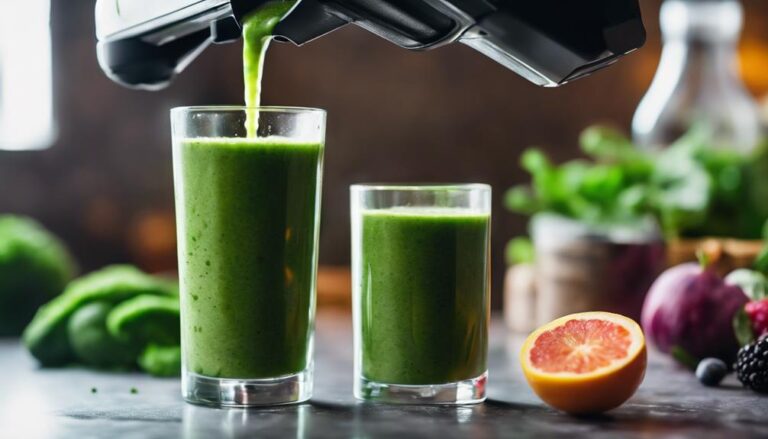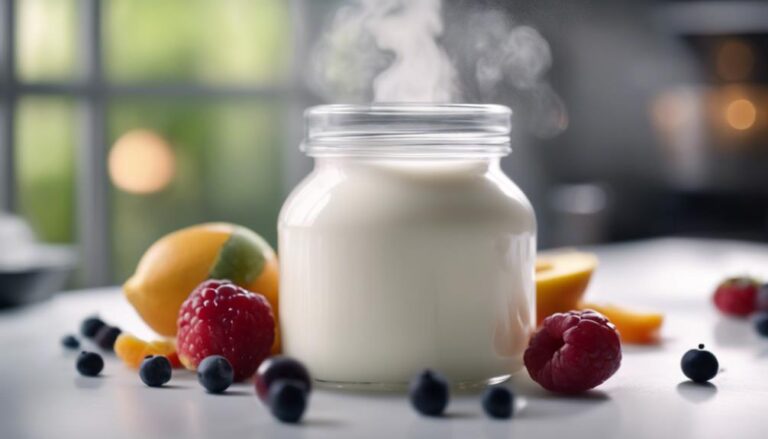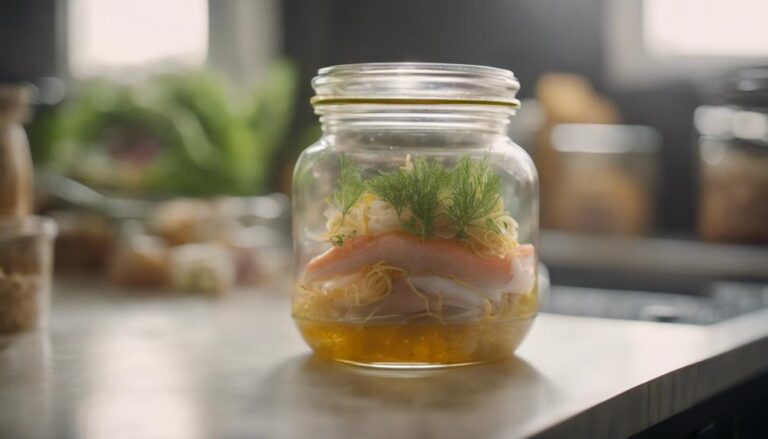Sous Vide Bison Steaks With Bone Broth Reduction
Immerse bison steaks in a sous vide bath for perfection. Seal in juiciness at 130°F for 2 hours for medium-rare. Sear briefly for a caramelized crust. Elevate with a bone broth reduction. Experience gourmet harmony of flavors.
What You Will Learn Here
- Bone broth reduction enriches bison flavor.
- Sous vide maintains tenderness and juiciness.
- Precise temperature control ensures perfect doneness.
- Elevates dining experience with gourmet quality.
- Harmony of flavors in a gourmet meal.
Sous Vide Cooking Origins
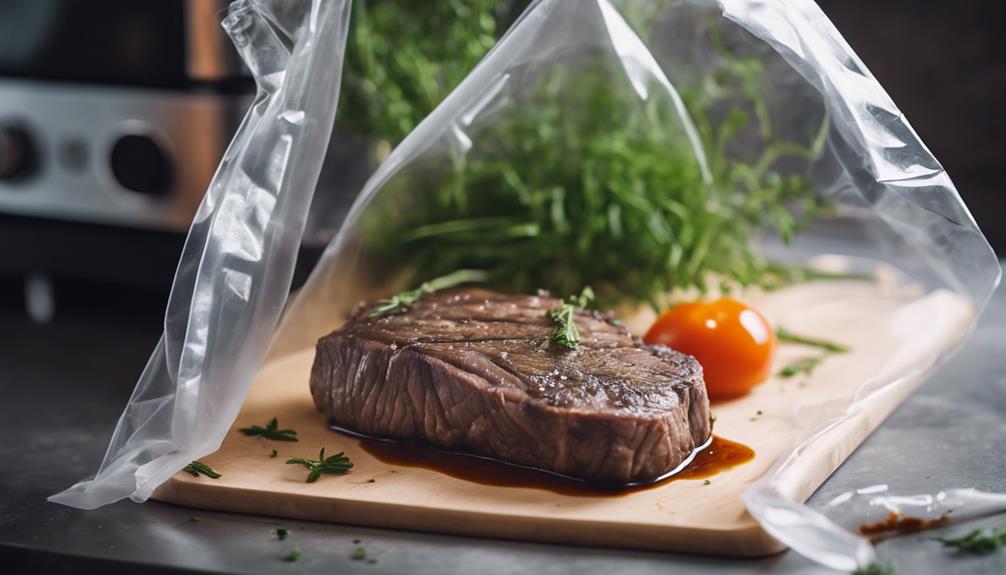
Sous vide cooking traces its origins back to 1970s France, where it first emerged as a method tailored for cooking foie gras.
This culinary technique entails sealing food in a bag and immersing it in a water bath set at an exact temperature.
Over time, sous vide cooking has garnered acclaim for its precision in temperature control, revolutionizing the way dishes are prepared in both professional and home kitchens.
Sous Vide History
Originating in the culinary landscape of late 1960s France, sous vide cooking emerged as a revolutionary method initially utilized for preparing foie gras. The term 'sous vide,' translating to 'under vacuum' in French, highlights the technique's use of vacuum-sealed bags during the cooking process.
Chef Georges Pralus was instrumental in pioneering sous vide cooking techniques for culinary applications, emphasizing precise temperature control and food quality maintenance. This method quickly gained popularity in professional kitchens for its ability to deliver consistent results.
Over the years, sous vide has evolved, becoming more accessible to home cooks with the introduction of user-friendly devices. Its history reflects a journey from a specialized culinary practice to a widely embraced cooking technique known for its exceptional outcomes.
Cooking Technique Evolution
The evolution of cooking techniques, particularly in the domain of culinary practices, showcases a continuous quest for refinement and innovation. Sous vide cooking, originating in the 1970s as a method primarily used by French chefs to cook foie gras, has since undergone significant advancements. Initially exclusive to high-end restaurants, the technique's popularity soared due to its ability to consistently cook food to precise levels of doneness.
Sous vide bison steaks, a modern application of this method, exemplify how this cooking evolution has brought enhanced flavors, textures, and nutrient retention to dishes. With the accessibility of affordable sous vide equipment, home cooks now have the opportunity to experiment with this refined culinary technique, elevating their cooking endeavors to new heights.
Precise Temperature Control
Amidst the culinary domain's evolutionary journey, the advent of precise temperature control through sous vide cooking in France during the 1970s revolutionized the approach to cooking food in vacuum-sealed bags. This technique has particularly benefited dishes like Bison steaks, allowing for a meticulous cooking process that guarantees the meat's best tenderness and juiciness.
Bison Ribeye Marinade Options
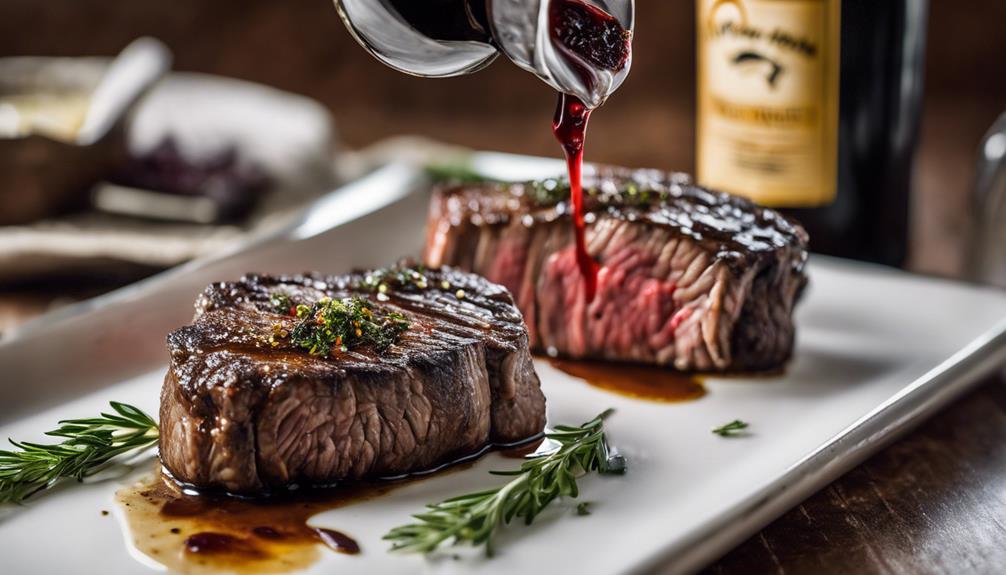
When considering how to enhance the flavor of your bison ribeye steaks, exploring various marinade options can be a rewarding culinary adventure. Different marinades can bring out unique tastes and textures, enhancing the natural richness of the bison meat.
Here are some options to inspire your next cooking endeavor:
- Savory Herb Blend: Marinate your bison ribeye with a mixture of olive oil, garlic, rosemary, and thyme for a robust and savory flavor profile that complements the meat's natural qualities.
- Citrus Infusion: Try a citrus-based marinade using lemon, orange, and herbs to add an invigorating twist to your bison ribeye steaks, creating a zesty and bright taste experience.
- Simple Elegance: For a straightforward yet delicious option, consider marinating your bison ribeye with a blend of salt, pepper, and a touch of balsamic vinegar to let the rich and lean nature of the meat shine through.
Experimenting with these diverse marinade options allows you to tailor the bison ribeye steaks to your preferences, offering a culinary journey filled with delightful flavors.
Sous Vide Bison Steak Variations
When exploring sous vide bison steak variations, consider trying a savory coffee rub on your bison steak for a unique flavor profile.
Experiment with coffee-infused bison ribeye to elevate the richness of the meat.
For a creative twist, venture into making bison ribeye sous vide tacos for a fusion of flavors that will delight your taste buds.
Savory Coffee Rub Bison Steak
Enhance the robust flavor profile of your bison steak by generously applying a savory coffee rub before searing post sous vide cooking.
- Customize Your Rub: Tailor your coffee rub by adding ingredients like cocoa powder, garlic, or paprika for a personalized touch.
- Crust Perfection: The combination of coffee and savory spices creates a delicious crust when searing the bison steak after sous vide cooking.
- Flavor Depth: Savory coffee rubs enhance the flavor of bison steak by adding depth and richness to the lean and robust meat.
Coffee-infused Bison Ribeye
To elevate your bison steak experience further, consider exploring the intriguing domain of coffee-infused Bison Ribeye through sous vide cooking.
When preparing this unique variation, make sure to follow these steps for a delectable outcome:
- Seal: Place the coffee-infused bison ribeye along with the bone broth reduction in a vacuum-sealed bag to lock in the flavors and guarantee a tender result.
- Sous Vide: Cook the sealed bag in a water bath at a precise temperature to achieve the perfect doneness while allowing the coffee flavors to infuse thoroughly.
- Finish: After sous vide cooking, sear the Bison Ribeye in a hot skillet to create a caramelized crust, enhancing the overall texture and taste of the dish.
Bison Ribeye Sous Vide Tacos
For a culinary adventure that tantalizes the taste buds and showcases the tenderness of bison ribeye, explore the world of Bison Ribeye Sous Vide Tacos.
- Sous Vide Perfection: Sous vide cooking guarantees a perfectly cooked bison ribeye, with precise temperature control ensuring juicy tenderness in every bite.
- Flavorful Fusion: The lean and rich flavor of bison ribeye enhances the traditional taco experience, offering a unique twist that will impress any taco enthusiast.
- Richness in Every Bite: The addition of a bone broth reduction adds depth and richness to the tacos, elevating the overall flavor profile and creating a truly satisfying dining experience.
Embark on a journey of exquisite taste and texture with Bison Ribeye Sous Vide Tacos, where each bite is a symphony of flavors perfectly orchestrated through the sous vide cooking method.
Sous Vide Bison Temperature Guide
When cooking bison sous vide, the temperature is essential for achieving the desired doneness. Setting your sous vide machine to 130°F will result in a perfectly tender and juicy medium-rare bison steak.
Following precise temperature recommendations is key to mastering the art of cooking bison sous vide.
Temperature Recommendations for Bison
Attaining ideal tenderness and flavor in bison steaks cooked sous vide necessitates precise temperature control within the range of 129-131 degrees Fahrenheit.
When cooking bison sous vide, temperatures ranging from 129 degrees yield a delectable medium-rare doneness, while slightly higher temperatures can achieve medium or medium-well results.
The sous vide method offers the advantage of precise temperature regulation, ensuring uniform cooking throughout the bison steaks. Bison meat benefits greatly from the slow, consistent cooking process of sous vide, resulting in a tender and succulent final dish.
To enhance the flavors, consider pairing the sous vide bison steaks with a bone broth reduction, adding a layer of depth and richness to your culinary creation.
Cooking Times for Bison
To achieve ideal tenderness and flavor in your bison steaks cooked sous vide, precise temperature control is essential, with recommended cooking times varying based on desired doneness levels.
For a medium-rare result, sous vide bison steaks at 130°F for 2 hours. Opt for 140°F for 2 hours to achieve a medium doneness. If you prefer a medium-well bison steak, cook at 130°F for 4 hours. For well-done bison steaks, set the temperature to 150°F and cook for 2 hours.
Utilizing a cast iron skillet after sous vide cooking can provide a quick sear for added texture and flavor. Remember, sous vide cooking guarantees precise temperature control, ensuring consistent and excellent results every time.
Sous Vide Tips for Bison
For ideal results when cooking bison sous vide, maintain a precise temperature range of 129-131 degrees Fahrenheit to achieve a delectably tender and juicy medium-rare doneness.
When preparing bison using sous vide, it's important to make sure the water temperature remains constant throughout the cooking process. By vacuum-sealing the bison steaks before immersing them in the water bath, you guarantee that the meat cooks evenly and retains its natural juices.
Additionally, seasoning the bison before vacuum-sealing allows the flavors to penetrate the meat thoroughly. Remember to sear the bison steaks in a hot pan after sous vide cooking to achieve a beautiful crust while maintaining the perfect medium-rare texture inside.
Final Thoughts
In reflection, the union of sous vide bison steaks and bone broth reduction elevates the dining experience to a domain of exquisite culinary delight. The tenderness and flavor of bison steaks, achieved through sous vide cooking, harmonize perfectly with the depth and richness that the bone broth reduction imparts. The precise temperature control provided by sous vide guarantees that each bite of the steak is cooked to perfection, tender and juicy, showcasing the quality of the meat in all its glory.
Moreover, the marriage of bison steaks with bone broth reduction not only creates a gourmet meal but also highlights the versatility and elegance of sous vide cooking techniques. This dish exemplifies how simple ingredients, when treated with care and precision, can result in a symphony of flavors and textures that delight the senses. When you serve sous vide bison steaks with bone broth reduction, you're offering your guests a culinary experience that's both sophisticated and satisfying, a true evidence to the art of cooking.
Frequently Asked Questions
How to Cook Bison Steaks Sous Vide?
To cook bison steaks sous vide, season them with salt, pepper, and herbs, then vacuum-seal for precise cooking. Set the sous vide machine to 129-131°F for tender and flavorful results. Sear after for a delicious crust.
What Temperature Is Best for Bison Steak?
For that perfect bison steak, aim for a temperature range of 130-135°F. Sous vide cooking guarantees precise results every time, sealing in moisture and tenderness. Trust the method; your bison steak will come out just right.
How Much Does Bison Shrink When Cooked?
When you cook bison, it typically shrinks about 25-30% due to moisture loss. The shrinking process is more noticeable in lean cuts like bison steaks. Factors like cooking method and initial moisture content affect the amount of shrinkage.
Why Is My Bison Steak Tough?
To uphold bison tenderness, guarantee precise cooking as lean nature can toughen meat. Connective tissue needs meticulous treatment. Sous vide gently cooks at precise temperatures. Sear for crust. Bone broth sauce adds flavor.
Conclusion
To wrap up, sous vide cooking offers a precise method for preparing bison steaks to perfection.
The use of bone broth reduction adds richness and depth of flavor to the dish.
By following the recommended temperature guide, you can achieve tender and juicy bison steaks every time.
Experiment with different marinade options to customize the taste to your liking.
Elevate your culinary skills with this sophisticated and delicious sous vide bison steak recipe.
